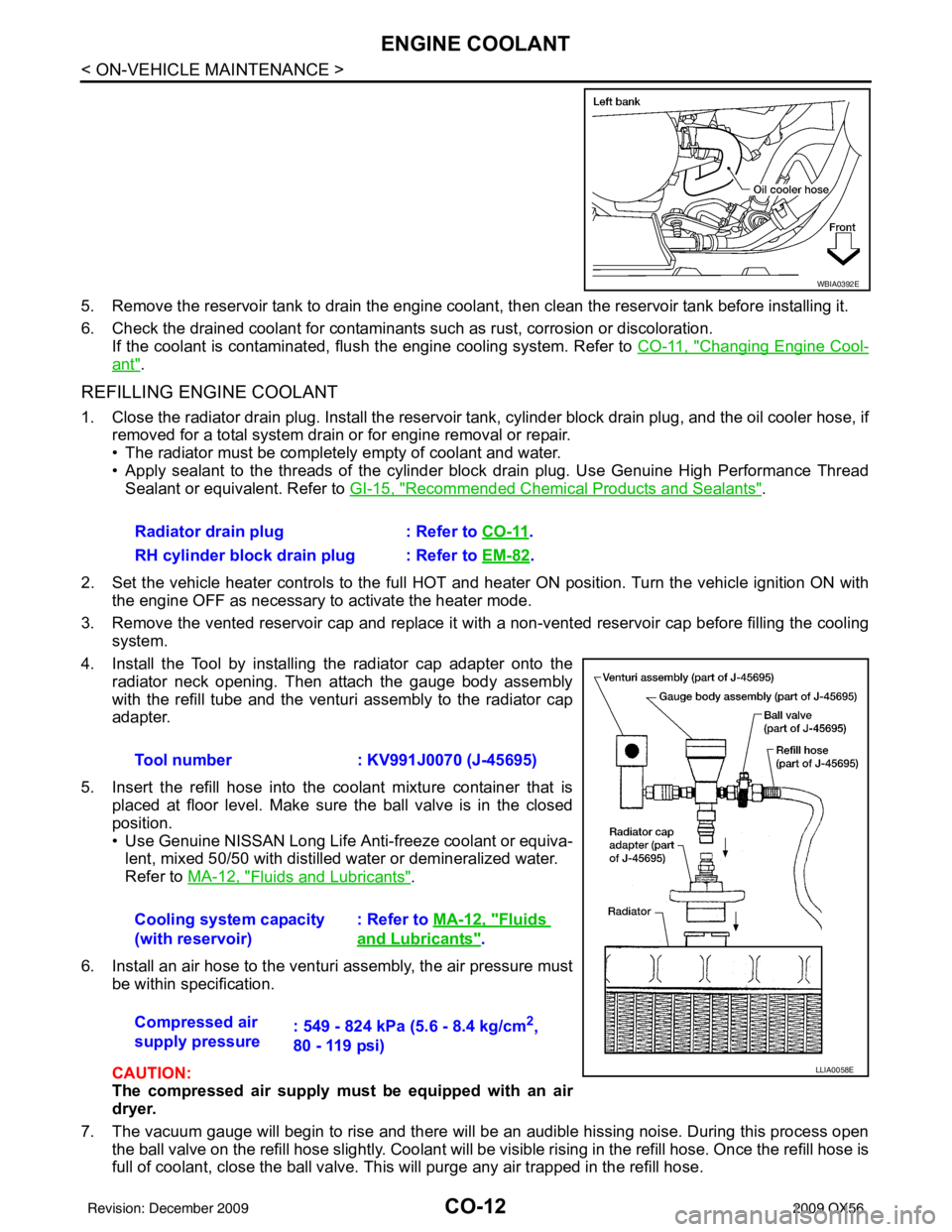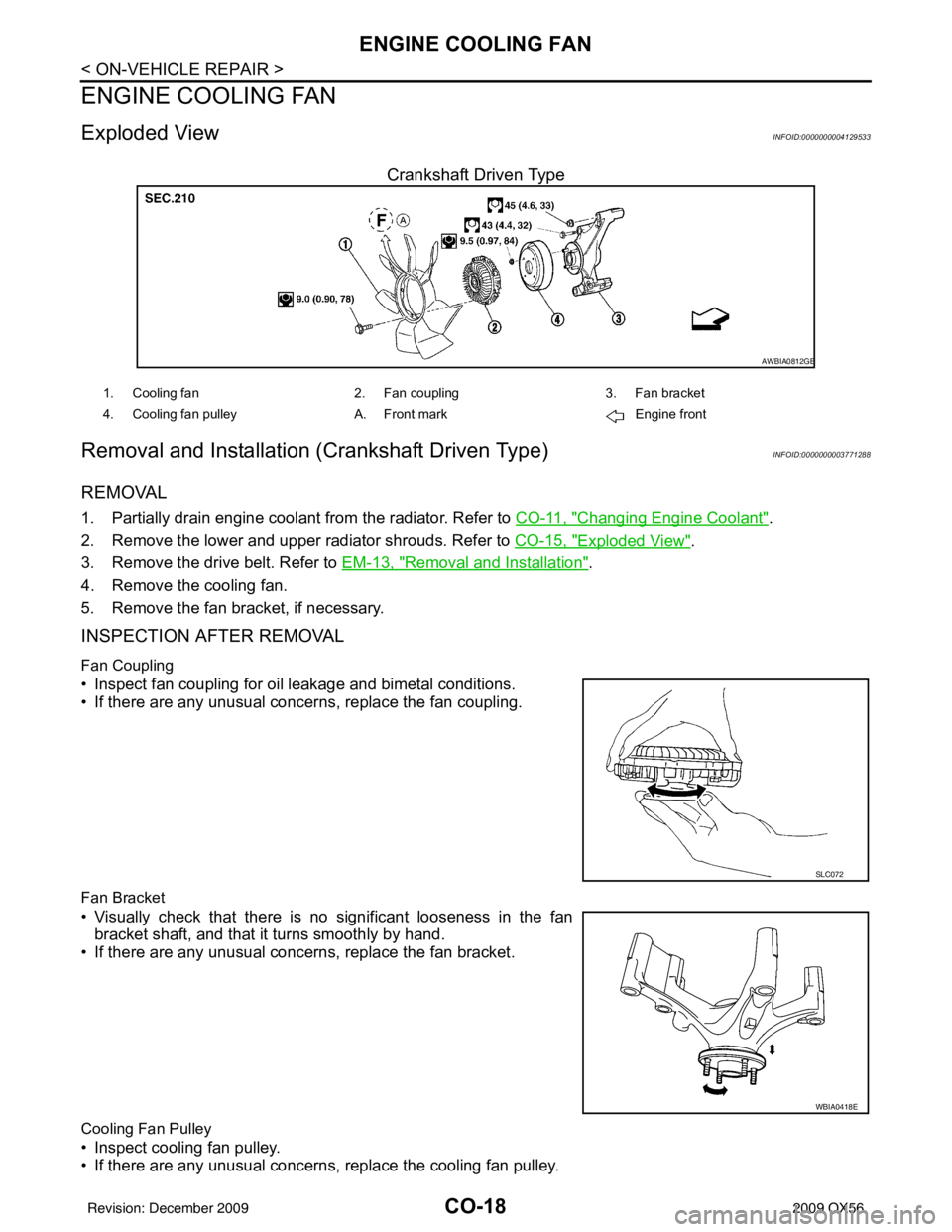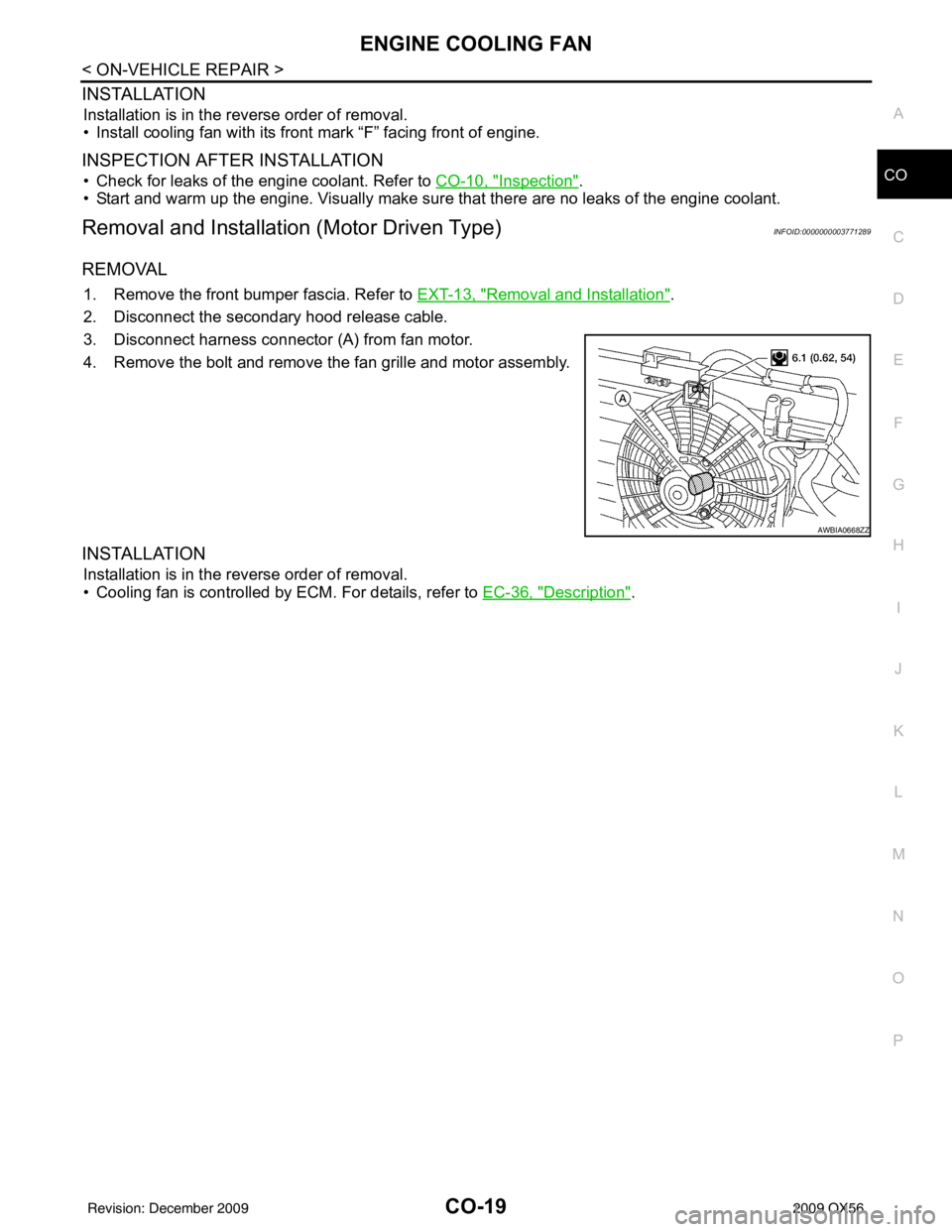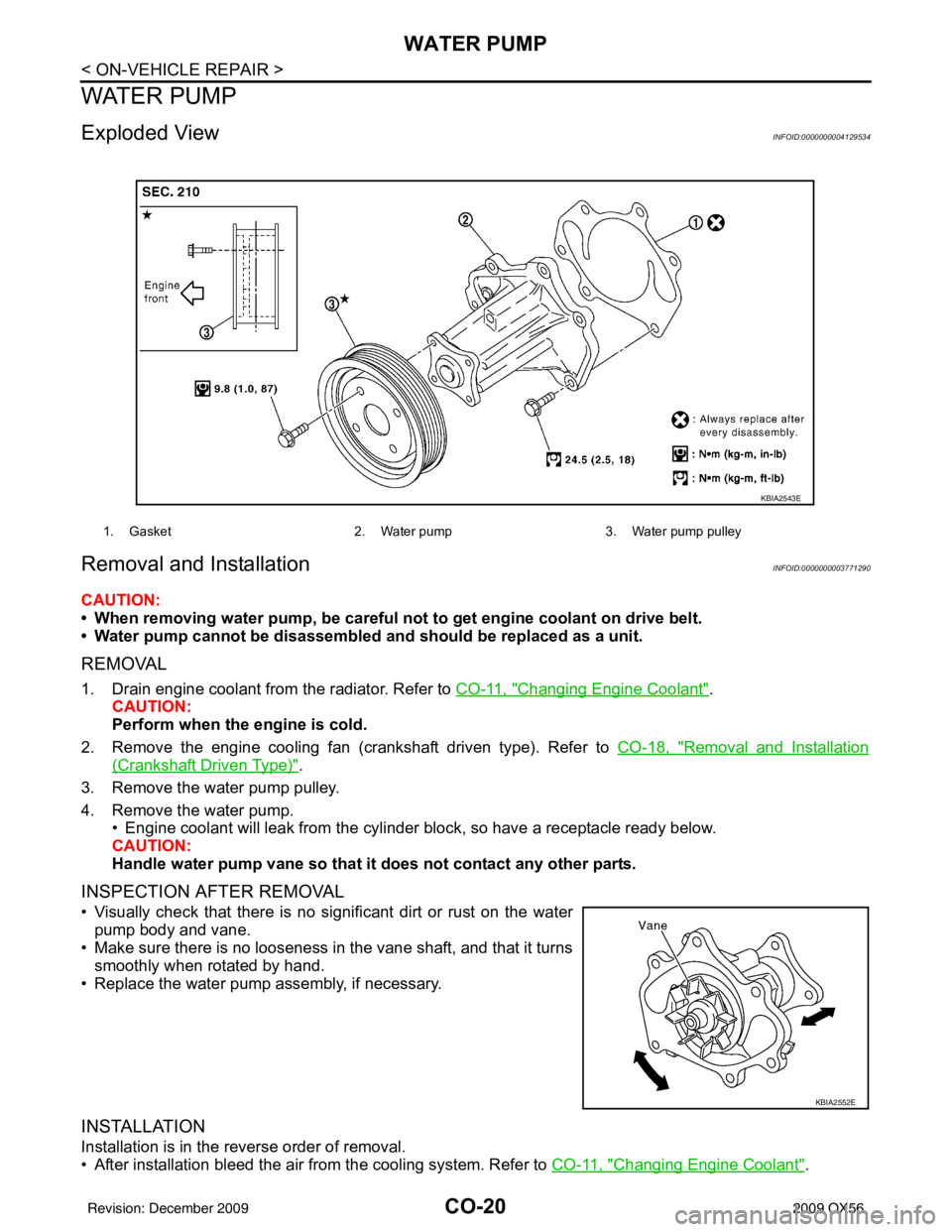coolant INFINITI QX56 2009 Factory User Guide
[x] Cancel search | Manufacturer: INFINITI, Model Year: 2009, Model line: QX56, Model: INFINITI QX56 2009Pages: 4171, PDF Size: 84.65 MB
Page 756 of 4171

CO-12
< ON-VEHICLE MAINTENANCE >
ENGINE COOLANT
5. Remove the reservoir tank to drain the engine coolant, then clean the reservoir tank before installing it.
6. Check the drained coolant for contaminants such as rust, corrosion or discoloration.
If the coolant is contaminated, flus h the engine cooling system. Refer to CO-11, "
Changing Engine Cool-
ant".
REFILLING ENGINE COOLANT
1. Close the radiator drain plug. Install the reservoir t ank, cylinder block drain plug, and the oil cooler hose, if
removed for a total system drain or for engine removal or repair.
• The radiator must be completely empty of coolant and water.
• Apply sealant to the threads of the cylinder bl ock drain plug. Use Genuine High Performance Thread
Sealant or equivalent. Refer to GI-15, "
Recommended Chemical Products and Sealants".
2. Set the vehicle heater controls to the full HOT and heat er ON position. Turn the vehicle ignition ON with
the engine OFF as necessary to activate the heater mode.
3. Remove the vented reservoir cap and replace it with a non-vented reservoir cap before filling the cooling
system.
4. Install the Tool by installing the radiator cap adapter onto the radiator neck opening. Then attach the gauge body assembly
with the refill tube and the venturi assembly to the radiator cap
adapter.
5. Insert the refill hose into the coolant mixture container that is placed at floor level. Make sure the ball valve is in the closed
position.
• Use Genuine NISSAN Long Life Anti-freeze coolant or equiva-lent, mixed 50/50 with distilled water or demineralized water.
Refer to MA-12, "
Fluids and Lubricants".
6. Install an air hose to the venturi assembly, the air pressure must be within specification.
CAUTION:
The compressed air supply must be equipped with an air
dryer.
7. The vacuum gauge will begin to rise and there will be an audible hissing noise. During this process open the ball valve on the refill hose slightly. Coolant will be vi sible rising in the refill hose. Once the refill hose is
full of coolant, close the ball valve. This will purge any air trapped in the refill hose.
WBIA0392E
Radiator drain plug : Refer to CO-11.
RH cylinder block drain plug : Refer to EM-82
.
Tool number : KV991J0070 (J-45695)
Cooling system capacity
(with reservoir) : Refer to
MA-12, "
Fluids
and Lubricants".
Compressed air
supply pressure : 549 - 824 kPa (5.6 - 8.4 kg/cm
2,
80 - 119 psi)
LLIA0058E
Revision: December 20092009 QX56
Page 757 of 4171

ENGINE COOLANTCO-13
< ON-VEHICLE MAINTENANCE >
C
DE
F
G H
I
J
K L
M A
CO
NP
O
8. Continue to draw the vacuum until the gauge reaches 28 inches
of vacuum. The gauge may not reach 28 inches in high altitude
locations, use the vacuum specifications based on the altitude
above sea level.
9. When the vacuum gauge has reached the specified amount, disconnect the air hose and wait 20 seconds
to see if the system loses any vacuum. If the vacuum level drops, perform any necessary repairs to the
system and repeat steps 6 - 8 to br ing the vacuum to the specified amount. Recheck for any leaks.
10. Place the coolant container (with the refill hose inserted) at the same level as the top of the radiator. Then
open the ball valve on the refill hose so the coolant will be drawn up to fill the cooling system. The cooling
system is full when the vacuum gauge reads zero.
CAUTION:
Do not allow the coolant container to get too low when filling, to avoid air from being drawn into
the cooling system.
11. Remove the Tool from the radiator neck opening and install the radiator cap.
12. Remove the non-vented reservoir cap.
13. Fill the cooling system reservoir tank to the specified level. Run the engine to warm up the cooling system and top up the system as necessary befor e installing the vented reservoir cap.
FLUSHING COOLING SYSTEM
1. Drain the water from the engine cooling system. Refer to CO-11, "Changing Engine Coolant".
2. Fill the radiator and the reservoir tank (to the “MAX” line), with water. Reinstall the radiator cap and leave
the vented reservoir cap off.
3. Run the engine until it reaches normal operating temperature.
4. Press the engine accelerator two or three times under no-load.
5. Stop the engine and wait until it cools down.
6. Drain the water from the engine cooling system. Refer to CO-11, "
Changing Engine Coolant".
7. Repeat steps 2 through 6 until clear water begins to drain from the radiator. Altitude above sea level Vacuum gauge reading
0 - 100 m (328 ft) : 28 inches of vacuum
300 m (984 ft) : 27 inches of vacuum
500 m (1,641 ft) : 26 inches of vacuum
1,000 m (3,281 ft) : 24 - 25 inches of vacuum
LLIA0057E
Revision: December 20092009 QX56
Page 759 of 4171

RADIATORCO-15
< ON-VEHICLE REPAIR >
C
DE
F
G H
I
J
K L
M A
CO
NP
O
ON-VEHICLE REPAIR
RADIATOR
Exploded ViewINFOID:0000000004129532
Removal and InstallationINFOID:0000000003771287
WARNING:
Never remove the radiator cap when the engine is hot.
Serious burns could occur from high-pressure
engine coolant escaping from the radiator.
REMOVAL
CAUTION:
Perform when the engine is cold.
1. Drain engine coolant from the radiator. Refer to CO-11, "
Changing Engine Coolant".
2. Remove air duct and resonator assembly. Refer to EM-25, "
Exploded View".
3. Disconnect A/T fluid cooler hoses. • Install blind plug to avoid leakage of A/T fluid.
4. Disconnect radiator lower hose from radiator. CAUTION:
1. Radiator 2. Bolt 3. Mounting rubber
4. A/T fluid cooler hose 5. Radiator hose (lower) 6. Flaps
7. Radiator shroud (upper) 8. Radiator shroud (lower) 9. Drain plug
10. Radiator hose (upper) 11. Reservoir tank hose 12. By-pass hose
13. Reservoir tank 14. Reservoir tank cap A. To radiator fill neck
B. To A/T cooler tube C. To water suction pipe D. To thermostat housing
WBIA0694E
Revision: December 20092009 QX56
Page 760 of 4171

CO-16
< ON-VEHICLE REPAIR >
RADIATOR
Do not allow coolant to contact drive belt.
5. Remove the lower radiator shroud. • Release the tabs, pull lower radiator shroud rearwards and
down to remove.
6. Disconnect the radiator upper hose and the coolant reservoir hose from the radiator. CAUTION:
Do not allow coolant to contact drive belt.
7. Remove the radiator shroud upper bolts and remove the radiator shroud upper (A).
8. Remove the upper radiator mounting bolts and rubbers.
9. Remove the A/C condenser bolts and brackets. NOTE:
Lift A/C condenser up and forward to remove from radiator.
10. Remove A/T oil cooler bolts and oil cooler from radiator and position aside.
WBIA0407E
WBIA0695E
WBIA0395E
WBIA0396E
Revision: December 20092009 QX56
Page 761 of 4171

RADIATORCO-17
< ON-VEHICLE REPAIR >
C
DE
F
G H
I
J
K L
M A
CO
NP
O
11. Lift up and remove the radiator.
CAUTION:
Do not damage or scratch air conditioner condenser and
radiator core when removing.
INSTALLATION
Installation is in the reverse order of removal.
INSPECTION AFTER INSTALLATION
• Check for leaks of engine coolant. Refer to CO-10, "Inspection".
• Start and warm up the engine. Visually check for leaks of the engine coolant and A/T fluid.
PBIC1536E
Revision: December 20092009 QX56
Page 762 of 4171

CO-18
< ON-VEHICLE REPAIR >
ENGINE COOLING FAN
ENGINE COOLING FAN
Exploded ViewINFOID:0000000004129533
Crankshaft Driven Type
Removal and Installation (Crankshaft Driven Type)INFOID:0000000003771288
REMOVAL
1. Partially drain engine coolant from the radiator. Refer to CO-11, "Changing Engine Coolant".
2. Remove the lower and upper radiator shrouds. Refer to CO-15, "
Exploded View".
3. Remove the drive belt. Refer to EM-13, "
Removal and Installation".
4. Remove the cooling fan.
5. Remove the fan bracket, if necessary.
INSPECTION AFTER REMOVAL
Fan Coupling
• Inspect fan coupling for oil leakage and bimetal conditions.
• If there are any unusual concerns, replace the fan coupling.
Fan Bracket
• Visually check that there is no significant looseness in the fan bracket shaft, and that it turns smoothly by hand.
• If there are any unusual concerns, replace the fan bracket.
Cooling Fan Pulley
• Inspect cooling fan pulley.
• If there are any unusual concerns, replace the cooling fan pulley.
AWBIA0812GB
1. Cooling fan 2. Fan coupling3. Fan bracket
4. Cooling fan pulley A. Front mark Engine front
SLC072
WBIA0418E
Revision: December 20092009 QX56
Page 763 of 4171

ENGINE COOLING FANCO-19
< ON-VEHICLE REPAIR >
C
DE
F
G H
I
J
K L
M A
CO
NP
O
INSTALLATION
Installation is in the reverse order of removal.
• Install cooling fan with its front mark “F” facing front of engine.
INSPECTION AFTER INSTALLATION
• Check for leaks of the engine coolant. Refer to
CO-10, "Inspection".
• Start and warm up the engine. Visually make sure that there are no leaks of the engine coolant.
Removal and Installati on (Motor Driven Type)INFOID:0000000003771289
REMOVAL
1. Remove the front bumper fascia. Refer to EXT-13, "Removal and Installation".
2. Disconnect the secondary hood release cable.
3. Disconnect harness connector (A) from fan motor.
4. Remove the bolt and remove the fan grille and motor assembly.
INSTALLATION
Installation is in the reverse order of removal.
• Cooling fan is controlled by ECM. For details, refer to EC-36, "
Description".
AWBIA0668ZZ
Revision: December 20092009 QX56
Page 764 of 4171

CO-20
< ON-VEHICLE REPAIR >
WATER PUMP
WATER PUMP
Exploded ViewINFOID:0000000004129534
Removal and InstallationINFOID:0000000003771290
CAUTION:
• When removing water pump, be careful not to get engine coolant on drive belt.
• Water pump cannot be disassembled and should be replaced as a unit.
REMOVAL
1. Drain engine coolant from the radiator. Refer to CO-11, "Changing Engine Coolant".
CAUTION:
Perform when the engine is cold.
2. Remove the engine cooling fan (crankshaft driven type). Refer to CO-18, "
Removal and Installation
(Crankshaft Driven Type)".
3. Remove the water pump pulley.
4. Remove the water pump. • Engine coolant will leak from the cylinder block, so have a receptacle ready below.
CAUTION:
Handle water pump vane so that it does not contact any other parts.
INSPECTION AFTER REMOVAL
• Visually check that there is no signi ficant dirt or rust on the water
pump body and vane.
• Make sure there is no looseness in the vane shaft, and that it turns smoothly when rotated by hand.
• Replace the water pump assembly, if necessary.
INSTALLATION
Installation is in the reverse order of removal.
• After installation bleed the air from the cooling system. Refer to CO-11, "
Changing Engine Coolant".
1. Gasket2. Water pump3. Water pump pulley
KBIA2543E
KBIA2552E
Revision: December 20092009 QX56
Page 765 of 4171

WATER PUMPCO-21
< ON-VEHICLE REPAIR >
C
DE
F
G H
I
J
K L
M A
CO
NP
O
INSPECTION AFTER INSTALLATION
• Check for leaks of engine coolant. Refer to
CO-10, "Inspection".
• Start and warm up engine. Visually c heck for leaks of the engine coolant.
Revision: December 20092009 QX56
Page 766 of 4171

CO-22
< ON-VEHICLE REPAIR >
THERMOSTAT AND WATER PIPING
THERMOSTAT AND WATER PIPING
Exploded ViewINFOID:0000000004129535
Removal and InstallationINFOID:0000000003771291
REMOVAL
Removal of Thermostat
1. Partially drain engine coolant from the radiator. Refer to CO-11, "Changing Engine Coolant".
CAUTION:
Perform when engine is cold.
2. Remove the air duct and resonator assembly. Refer to EM-25, "
Exploded View".
3. Disconnect the water suction hose from the water inlet.
4. Remove the water inlet and thermostat.
Removal of Thermostat Housing, Water Outlet and Heater Pipe
1. Remove the intake manifold. Refer to EM-26, "Removal and Installation".
2. Remove the thermostat housing, water outlet and heater pipe.
Removal of Water Cut Valve
1. Partially drain the engine coolant from the radiator. Refer to CO-11, "Changing Engine Coolant".
1. Heater pipe2. Gasket 3. Water outlet
4. Gasket 5. O-ring 6. O-ring
7. Thermostat housing 8. Rubber ring 9. Thermostat
10. Water inlet 11. Water suction hose 12. Water suction pipe
13. Gasket 14. Heater pipe
KBIA2501E
Revision: December 20092009 QX56